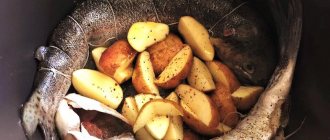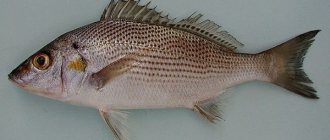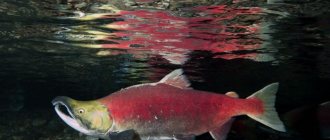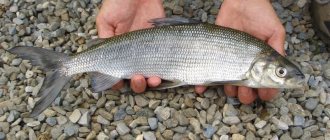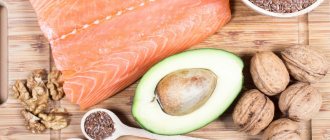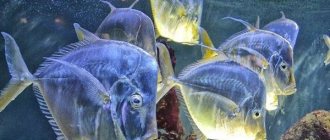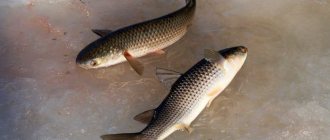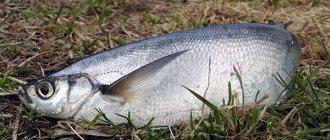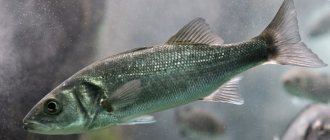What kind of fish, what does it look like and where is mullet found?
Mullet is a marine ray-finned fish from the Mullet family, reaching up to 1 m in length from head to tail. The body is elongated, similar in shape to a torpedo, covered with large silver-gray scales with black stripes in the upper part. There are 4 fins, 2 on the back and 2 on the belly.
The fish has no teeth, but the lower lip is very sharp, and it is responsible for grinding food. The marine life feeds mainly on mud and can also eat invertebrate marine life and worms.
You can recognize a mullet by its long, straight body with large silvery scales.
Males mature at 6 years of age, and females become ready to lay eggs at 8 years of age. Spawning lasts from early summer to autumn, at the end of this period the fish migrate to fresh waters.
Mullet does not make high demands on the composition of sea water, so it can be found in waters all over the world in tropical and subtropical climates. Sometimes representatives of the genus live in fresh water bodies, for example, some species live in lakes in Australia, Madagascar and New Zealand. The fish cannot be found only in the Arctic Ocean because it is too cold for them.
What does mullet eat?
The fish's diet is based on natural silt, from which the mullet receives nutrients. It also feeds on small aquatic inhabitants:
- worms;
- invertebrates;
- zooplankton.
Feeding migration begins for gray fish in mid-summer. Some of the flocks that entered the estuaries spend the winter there. A large percentage of fingerlings do not return after winter. However, the population persists due to the high fertility of individuals.
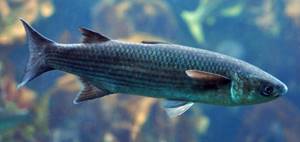
Types of mullet
There are 3 varieties of sea fish common in Russia. They differ from each other in size and life cycle characteristics.
Black Sea mullet
The Black Sea mullet is the most famous Russian variety. The sea fish has an elongated body with a flattened back, its scales are gray, lighter on the belly, its nose is sharp, and there are 2 black stripes in the upper part of the body.
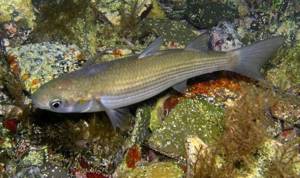
Black Sea mullet lives up to 15 years
The length of the Black Sea variety reaches an average of 40 cm. It spawns in the estuaries of the Black Sea.
Caspian mullet
The fish differs from the Black Sea fish in its larger size and reproduction characteristics. The Caspian variety does not spawn in estuaries, but directly in open sea waters, while the eggs remain on the surface of the water along with plankton. A photo of a mullet living in the Caspian Sea shows that the fish looks exactly the same as in other water areas. Her body is elongated and straight, silver-gray, with small fins on her back and belly.
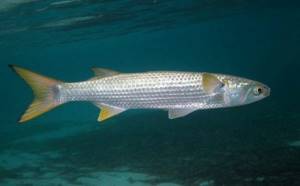
The Caspian mullet is slightly larger than the one that lives in the Black Sea
Important! Mullet appeared in the Caspian Sea only in the 1930s, and it was brought artificially from the Black Sea water area.
Azov mullet
The smallest variety, not exceeding 30 cm in length. The body of the fish is covered with medium-sized gray scales; black stripes can be seen on the back. As the name implies, mullet lives and breeds in the Sea of Azov.
Despite its small size, the fish is highly valued. It is very fatty and is beneficial when consumed as food.
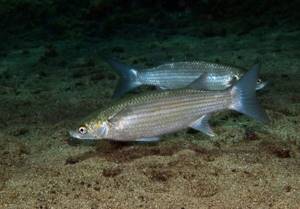
The Azov mullet is called the crane
Mullet taste qualities. What is a mullet
The warm waters are home to the commercial fish mullet. Habitat: sea. The population of the mullet family lives in the seas of subtropical and tropical regions. Some of the species can live in freshwater rivers. They can grow up to a length of 50 cm. Individuals are characterized by shiny scales and a small mouth. Gray mullet are distinguished by great mobility; they can jump out of the water and jump over fences.
These representatives of the ichthyofauna have a body shaped like a torpedo. The scales are large and round. The nose of the fish is located at the same level as the dorsal fin. The lifespan of sea and river inhabitants is up to 15 years. Sexual maturity of males occurs at 6-7 years, and spawning of females is possible at 8-9 years. There are more than 100 subspecies of this fish, living in different bodies of water:
- mullet mullet (black) - a popular large variety, whose habitat is the Japanese, Azov, and Black Seas, can weigh up to 2.5 kg;
- sharpnose (chularka) - the smallest representative of the mullet, weight about 500 g, length - 25 cm,
- singil (serendaka) – a common Black Sea mullet, carcass weight – up to 1 kg;
- pelengas - habitat of the Far Eastern waters;
- hoturo, cestrets are rare species that prefer fresh water bodies.
Representatives of the family are found not only in natural conditions, in the seas, oceans, and river mouths. The high nutritional value and excellent taste of the product have led to the fact that many countries are trying to grow fish in artificial reservoirs. A decrease in the number of fish in the sea, the lack of a constant successful bite and high demand for this species among consumers are the reasons for breeding them in special complexes.
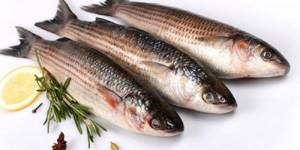
Chemical composition of mullet and calorie content
Sea fish is valued not only for its taste, but also for its high benefits. It contains the following substances:
- vitamin A;
- B vitamins, including B4, especially valuable for blood vessels;
- phosphorus;
- fatty acids in large quantities;
- iron, zinc and manganese;
- ascorbic acid;
- sodium, calcium and potassium;
- proteins and amino acids.
The product is predominantly represented by proteins, about 18 g in an unprocessed carcass. Fats occupy only 2.5 g, and there are no carbohydrates at all.
The calorie content of mullet per 100 grams is 125 calories if the fish is fresh. Boiled carcasses are less nutritious and contain 115 calories, stewed ones - no more than 80 calories.
Attention! Fried fish is considered the most nutritious; a 100 g serving contains up to 190 calories. However, there is somewhat less benefit in it than in boiled or stewed dishes.
Calorie content of mullet
100 grams of mullet contain 121 kcal. Fish does not contain carbohydrates, but is rich in a large percentage of proteins. This composition makes it a dietary product. It is digested in the stomach in 3 hours.
Full composition of mullet:
- proteins - 21 grams;
- fats - 0.4 grams;
- carbohydrates - 0 grams;
- vitamin PP - 2.8 mg;
- potassium - 367 mg;
- calcium - 561 mg;
- magnesium - 29 mg;
- sodium - 65 mg;
- nickel - 6 mg;
- fluorine - 430 mg;
- chlorine - 165 mg;
- zinc - 0.6 mg;
- calories - 121 kcal.
How does a mullet differ from a pelengas?
Sometimes the mullet is confused with the pelengas, another fish from the same family, which also lives in the Black and Azov seas. There are certainly common features between them, but there are also important differences.

The easiest way to distinguish a pelengas from a mullet is by their orange eyes.
Pelengas on average reaches larger sizes, up to 150 cm from head to tail. The eyes of the fish are not blue, like those of the mullet, but orange or reddish. The scales are much larger, but not as dense.
According to the type of feeding, the pelengas belongs to the bottom species of fish and lives at great depths. They also go to spawn at other times, in May and June.
How to properly cut a mullet
Cutting fish is not a complicated process. The sequence of actions is as follows:
- Remove scales.
- Gut her insides.
- Cut off the head using a sharp knife.
- Make a cut along the ridge.
- Remove the fin.
- Carefully separate the backbone from the meat.
- Cut off the fins and tail of the fish.
Note! For cutting, it is best to use a very sharp knife and special fish scissors.
In reviews, experienced housewives recommend choosing a plastic or glass board, since the wooden version absorbs the smell. To speed up cleaning, it is recommended to initially place newspaper or parchment under the fish, and then throw it away along with the remaining scales.
What are the benefits of mullet?
Fatty sea fish can bring great benefits to the human body. With proper heat treatment and moderate consumption of mullet:
- has a beneficial effect on the condition of the skin, and also takes care of eye health and improves vision;
- saturates the body with essential fatty acids, against the background of which metabolism accelerates and the functioning of the digestive tract returns to normal;
- improves the condition of blood vessels, strengthens memory and concentration;
- protects against the development of heart attacks and strokes, as it prevents the development of atherosclerosis and thrombosis;
- is a valuable source of amino acids necessary for building muscles;
- has a positive effect on the nervous system and prevents the development of depression and anxiety.
Like most marine fish, mullet helps strengthen joints, nails and teeth due to the presence of phosphorus in the composition.
For women
Sea mullet allows women to take care of the beauty and freshness of their skin. Fish contains a lot of fatty acids and a high amount of retinol, so the beneficial effect for the epidermis occurs very quickly.
Eating a seafood product for women is useful for anxiety, constant stress and sleep disorders. Fish carcasses contain many B vitamins, which are responsible for the functioning of the nervous system. Boiled mullet can be included in the diet; its calorie content is low, and if taken in small dosages, it will not lead to weight gain.

Mullet helps women cope with stress and depression
Is it possible to have a mullet during pregnancy and nursing mothers?
Fatty acids and microelements in sea fish make it useful for pregnant women. Mullet helps prevent anemia and vitamin deficiency, strengthens the immune system, prevents hair loss and deterioration of skin condition in expectant mothers.
But at the same time, fish may contain such a dangerous element as mercury. In minimal quantities it is harmless to a woman’s body, but can pose a threat to the child. Therefore, the consumption of fish during pregnancy must be agreed with your doctor. When breastfeeding, it is better not to introduce mullet into the diet until the baby is 10 months old.
For men
Regular consumption of seafood allows men to strengthen the walls of blood vessels and reduce cholesterol levels. Fatty acids and trace elements in fish prevent the development of heart pathologies. Seafood helps men cope with high blood pressure and also saturates the body with amino acids necessary for healthy muscle growth.
For children
The minerals and fatty acids in mullet may be beneficial for the child. However, fish can be introduced into a baby’s diet no earlier than 10 months, at the same time as complementary foods with meat. The initial dosage should be no more than 10 g.
Mullet ear should not be given to a child under 3 years of age. Dangerous substances remain in fish broth, in particular mercury, which can pose a threat to the baby’s body even in minute quantities. In addition, children's sensitive intestines may not be able to digest a fatty product.

Boiled mullet is given to a child no earlier than 10 months, and soup - only after 3 years
Attention! Sea mullet has contraindications, so it can only be included in your baby’s menu after consultation with a pediatrician.
When losing weight
Low-calorie mullet can be part of a diet; it will not lead to weight gain. Dill soup with sea fish is very popular when losing weight; its nutritional value is low, but it has a very good effect on digestion.
The soup is prepared according to this algorithm:
We recommend reading: Celery: beneficial properties and contraindications
- First, boil 800 g of mullet with salt and bay leaf and vegetables - onions and carrots - in different pans;
- after 7 minutes the fish is placed on a plate;
- boil 2 eggs separately, lightly fry celery and fresh dill, then mix with a large spoon of flour;
- pour the greens with water and boil for another 5 minutes;
- The yolks are removed from the eggs and mixed with 150 ml of sour cream, and the whites are finely chopped.
Recommended reading: The benefits of chicken eggs
All components are dipped into vegetable broth and stirred thoroughly. When serving, first put the fish fillet on the plate, then pour in the fish soup and, if desired, flavor the soup with basil to taste.
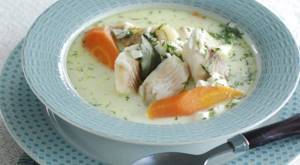
Mullet soup on a diet satisfies well, but does not lead to weight gain
Beneficial properties for the human body
Fish has many beneficial properties for the health of adult men and women due to its saturation with Omega-3 fatty acids: they thin the blood, prevent heart attacks and strokes, eliminating blood clots in the blood vessels of the body.
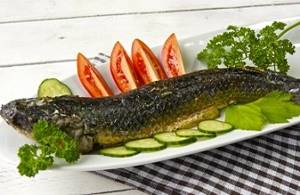
With high nutritional value, the individual contains few calories, many microelements, vitamins for a complete metabolism. Including dishes from this fish in the diet ensures the prevention of diseases of the gastrointestinal tract and atherosclerosis.
The effect of mullet on other categories of people is different, including the effect that can cause harm to the body:
- Pregnant and lactating women should consult a doctor before consuming the product. Among other microelements, fish contains mercury in quantities that may be dangerous for the baby.
- Children should introduce mullet to the menu no earlier than ten months of age after they have become accustomed to meat products. They start with a daily norm of 5–10 g, bringing it to 70 grams per day by 1 year. Fish broth contains substances harmful to babies. Its nutritional value is low: it is not recommended for children under three years of age.
- Older adults need large amounts of low-calorie nutrients to support their bodies. Fish is rich in those microelements and vitamins that are necessary for human life support - this improves the general condition of the nervous, cardiovascular systems of the body, and the gastrointestinal tract.
To ensure that the benefits do not decrease during the cooking process, it is recommended to bake or steam the carcasses. Eating fish at least 2 times a week will help maintain a good mood.
The best way to cook mullet
Sea fish is suitable for a wide variety of processing methods. For example, it can be:
- boil or fry;
- smoke or wither;
- prepare canned fish;
- bake in the oven;
- stew or simply pickle the product.
The most useful ways to prepare mullet fish are boiling and baking. When using these methods, the maximum amount of valuable substances is preserved. At the same time, the fish does not acquire harmful properties during processing. True, it is recommended to drain the broth from under the product; it contains compounds harmful to the body, albeit in minimal quantities.
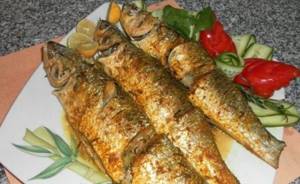
Baked mullet is the most useful, it retains the maximum of valuable substances
Advice! To make it easier to clean the fish, it is recommended to first pour boiling water over it for 1 minute; after this, the scales will be easier to separate.
Are there bones in a mullet?
The number of bones in a mullet is minimal. Every housewife can easily clean fish of them in a couple of minutes. The white meat of the sea creature is distinguished by its high taste. It is tender and juicy. Since fish is rich in protein (20% of all components), it perfectly saturates and gives energy. Housewives can safely buy this type, because it is not bony.
You can cook fish in different ways:
- fry;
- bake;
- cook;
- stew with vegetables.
Harm of mullet to the body and contraindications
Healthy mullet, when properly processed and consumed according to recipes, rarely harms the body. However, it still has some contraindications. It is necessary to give up sea fish:
- if you are allergic to the product;
- for acute diseases of the stomach and intestines;
- with exacerbation of pancreatitis.
It is better not to eat seafood during pregnancy and breastfeeding. If you have liver disease or weakened blood vessels, it is not recommended to eat fried mullet. Before consumption, the seafood product must be thoroughly boiled; bacteria and helminths may be present in the carcasses, and long-term heat treatment can completely eliminate them.
Distinctive features of the mullet
The structure of the body and the presence of many fins allows the mullet to move quickly, perform extraordinary maneuvers, and jump out of nets and high fences. The fish is nimble, but shy. Prefers to stay in small flocks. The main food is plant substrates contained in the bottom silt.
The mullet's diet also includes zooplankton from a variety of worms and small invertebrates. The fish lives on average 12-16 years. The length of an adult specimen varies from 30 to 90 cm. For industrial catches, the standard weight is 400 g, with a record weight of about 8 kg.
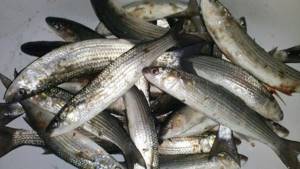
The benefits and harms of mullet caviar
Not only the mullet itself, but also its caviar has a beneficial effect on health. Fish eggs contain a huge amount of vitamins and minerals, in particular potassium, iodine, iron and calcium. Caviar is good for lymph flow and immunity, improves blood composition, prevents the appearance of atherosclerosis and anemia. With regular use of the product, brain function is activated and vitality increases.
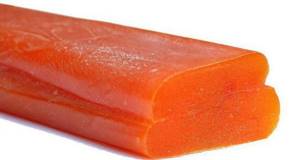
Mullet caviar has a valuable composition, but its price tag is high
From the point of view of gastronomic value, caviar even surpasses the beneficial properties of mullet. But there is also a drawback - such seafood is very expensive. Its taste is very pleasant, but for most people the delicacy is not available on an ongoing basis.
As for harm, caviar does not pose a danger to humans when consumed in moderation. In the absence of individual allergies, it will only bring health benefits.
Directions for using fish dishes
The main purpose of the mullet is to meet human food needs. Cooking is the main, but not the only, use of fish. Other areas include therapeutic and prophylactic use, including traditional medicine, and cosmetology.
Foods in cooking
There are many options for preparing fish: it can be baked in foil with vegetables, fried over a fire, smoked, salted and dried, turned into fish soup, or canned. Mullet is used in Italian and Caucasian cuisines.
Pairs well with vegetables and citrus fruits. Dishes are prepared in olive, sesame or sunflower oil with seasonings - thyme and black pepper.
Here are some recipes:
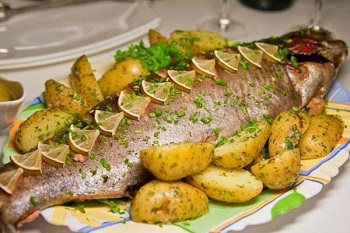
- Caucasian buglama made from mullet. For cooking you will need: 500 g of potatoes and water, 2 pcs. onions and sweet peppers, tomatoes – 4, garlic – 3 cloves, 350 grams of fish fillet. Spices (cilantro, paprika, suneli hops) are added to taste. The mullet, like tomatoes and peppers, is cut into small cubes, the onion into half rings, the grass is finely chopped.
All ingredients are loaded into a baking dish in order: fish, potato slices, onions and peppers, tomatoes.The dish simmers in the oven for 45 minutes, adding water if necessary. When the product is ready, place it on a plate and cover it with chopped herbs.
- Mullet (3 kg) with fennel (1 piece) and lemon grass (4 tablespoons). Gut the fish and stuff it with crushed ingredients with the addition of chopped fruits: lemon - 1 piece, ginger and cilantro - 30 and 150 g, garlic - 4 cloves, olive oil - 50 g.
Salt and pepper - to taste. Place the fish in a baking dish and place in the oven at 140 ºС for 1 hour.
To simplify cleaning the mullet, place it in boiling water for 30-60 seconds - the scales will easily separate. They start the process from the tail and move towards the head.
The daily intake of fish for an adult is 120 g. The time for eating mullet dishes is arbitrary, but lunch or dinner is considered optimal: it is better to eat carbohydrate foods for breakfast.
Video recipe for cooking mullet on a bed of pumpkin:
Diet for weight loss
Low calorie content determines the inclusion of fish dishes in the dietary category. Dill mullet soup is one of the remedies for weight loss.
To prepare it, you will need: 800 g of carcass, 1 head of onion and carrot, half a root of celery, dill and parsley, 1 bay leaf and 3 peppers, 1 spoon of flour and butter, salt. To serve – 2 eggs and 150 g of sour cream.

Cooking procedure:
- boil 1.5 liters of water. Peel the vegetables, chop them coarsely and add them to the pan, cook for 7 minutes;
- free the fish from scales, gills and intestines, place in the same bowl with bay leaf, salt and pepper, boil for 7 minutes, transfer the carcass from the broth to a plate and cover;
- Peel the hard-boiled eggs, finely chop the parsley and dill, fry in another pan for 1 minute, then add flour and stir;
- pour the fish broth into the bowl with the herbs, stirring constantly, cook for 5 minutes;
- disassemble the finished mullet into pieces. Grind the yolks with sour cream, finely chop the whites, put the entire egg mass into the soup and stir, remove from the stove.
Place pieces of fish into plates and pour fish soup. The dish will taste better if you add basil to it.
In medicine
Regular consumption of fish helps cleanse the arteries and leads to lower blood pressure levels. There is also a folk recipe for treating joints. The order is:
- Gut fresh fish without removing scales, rinse with water, spread along the backbone and cut into palm-sized pieces;
- apply the mullet dies with the inside to the sore joint, secure with a bandage;
- Remove the compress placed in the evening in the morning, but not earlier. Wash the cleared area with warm water and soap.
The course of treatment lasts 10 days, but the patient feels relief after 5 days. Sometimes a similar procedure is practiced using frozen mullet. Heel spurs are treated in the same way.
Mullet fat in cosmetology
Used for facial skin - it smooths out wrinkles and restores freshness due to the presence of Omega-3. Before applying the mask, clean the surface and remove moisture with a napkin.

Types of care:
- Homemade application of fish oil to the face against wrinkles - smooths out wrinkles, prevents the formation of age spots and wrinkles. Ingredients: 1 tsp. fat, 1 tbsp. l. starch and ginger oil. Mix everything and add potato powder. Leave on face for 1 hour.
- Anti-acne mask: 3 ml of fat, 10 g of blue clay, 15 mg of calendula mixed with natural sorbent. Remove after 30 minutes with lemon water.
- Around the eyes: grate 3 leaves of parsley, add 5 ml of fat. Moisten the gauze and apply it to the eyelids after 30 minutes. take off.
Possible combination with honey - restores elasticity, with sour cream and quail eggs - against dry skin.
Having become familiar with the beneficial properties of mullet and understanding when it can be harmful to human health, you can decide to become closely acquainted with the culinary delights of the fish diet.
With the right approach to choosing fresh fish, a person’s well-being will improve, regardless of his age.
How to choose and store fish correctly
Only fresh sea fish can be tasty and healthy. Therefore, when buying a mullet, you need to pay attention to several nuances:
- Eye condition. If the fish was caught recently and stored according to all the rules, then its eyes will be bright and transparent. Cloudy eye sockets with an almost indistinguishable pupil indicate that the mullet has already begun to deteriorate and will not bring any benefit to the body.
- Fit of scales. If the fish is fresh, then cleaning its carcass is quite difficult; you even have to resort to tricks and scald the product with boiling water. Scales that come off easily and without effort, as well as dents and damage on the mullet’s body indicate the beginning of rotting processes.
- Degree of elasticity. You need to press firmly on the fish carcass; if the mullet is fresh, the dent will disappear immediately, and if it has already begun to deteriorate, then the finger mark will remain on the body.
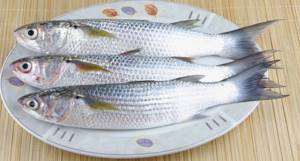
Fresh mullet should be elastic, with dense scales and clear transparent eyes.
Attention! When buying frozen fish, you need to make sure that there is no ice on its carcass. The presence of the latter indicates that the mullet has already been defrosted and then put back into the freezer; this always has a negative impact on the benefits.
You can keep fresh fish in the home refrigerator without heads and gills for no longer than 2 days, then it will begin to deteriorate. To preserve mullet for a long time, you can wrap it in foil, put it in a dry container with a lid and put it in the freezer. In this case, the product can be used even after 2 months. You will need to defrost and cook the whole carcass; cutting it into pieces and putting one of the pieces back into the cold will no longer work.
In which bodies of water in Russia can you catch
Mullet chooses salty seas, where it remains until spawning. For industrial purposes, this species is caught for sale fresh, frozen and for preservation. Nereis and sandworm (sea worms) are used as bait. Fishermen in Russia can catch it in 4 seas. Delicious fish are found in the following bodies of water:
- Azovskoe;
- Caspian;
- Black;
- Japanese.
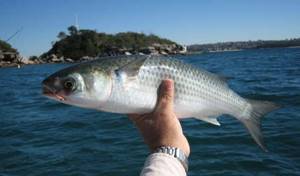
There are 4 species of this fish in Russian reservoirs:
- mullet;
- singil;
- bearing;
- sharp-nosed
Interesting! The best tackle is a feeder or match float rod. You can catch many individuals with it at once.
Black Sea mullet: fishing and its features
For industrial scale it is caught everywhere. In summer, fish bite well in estuaries and river mouths. Fishing is carried out at a depth of three to five meters. Anglers consider catching mullet an art. There are ten different fishing methods, some of which are prohibited by law. The most popular and best fishing options are donk or float.

Despite the fact that the Black Sea mullet has several subspecies, they all look for food in the bottom layers, lead a single lifestyle and swim in schools. This fish is caught mainly with worms, nereis and sandworms. They can be found on the coast at low tide or simply bought in fishing shops. The mullet bite is best from the beginning of August. At this time, the fish swims straight to the shore to have a good meal before wintering.
You need to look for mullet on the coast, joining a crowd of fishermen concentrated in one place. In a more deserted place, the bite may not be as successful. For fishing, you need to choose a coast with a rocky or pebble bottom. This is where the silt lingers, which is what this fish feeds on.
Fishing will be more successful if you feed the mullet several days before fishing. Fresh white bread (a couple of loaves) is great for this. It needs to be broken and placed in water for half a minute. Then it is simply ground to a thick sticky mass. Add 150 grams of processed cheese and some small pebbles (no more than a third of the total bait). Then the baits are molded. In a few days, the mullet will get used to the fact that there is always food here, and by the time of fishing, the entire flock will be swimming in this very place.
Features of structure and reproduction
Some people don’t even know what kind of fish mullet is or what it looks like in real life; they’ve only seen it in photos. The body of the mullet is long, elongated, torpedo-shaped, covered with large, round, silvery scales. The head is pointed and small. The eyes are large, the eyelids are wide and fat.
The nose and dorsal fin are almost on the same line. The fish's mouth is quite small, almost toothless, with a pointed lower lip. The body is colored gray on the back, silvery white on the belly. The sides are light, covered with longitudinal dark stripes.
Two fins are located on the flattened back, the front one has spiny rays. There are two more fins on the belly. The structure of the body and the presence of many fins allow the mullet to move quickly, perform extraordinary maneuvers, and jump out of nets and high fences. Prefers to stay in small flocks.

Sexual maturity in female mullets occurs at 7-9 years of age. Males mature earlier - by 6-7 years. Mullet is quite prolific; one brood produces an average of about 7 million eggs. Before spawning begins, it migrates to the lower reaches of rivers, estuaries and bays, where it feeds intensively.
The spawning period lasts from May to September. To spawn, the fish returns to the sea, where it lays eggs in sandy shallow waters, well warmed by the sun's rays. Having completed spawning, the mullet either goes back to the estuaries and bays to feed, or remains in the sea for the winter. In any case, this fish does not make large migration movements.
Eating mullet
Mullet is a valuable industrial fish that has excellent taste. Fish from the Black and Azov Seas, which is caught in early spring or late autumn, is considered incredibly tasty. In the Caspian Sea, the fish are slightly larger and have less fat content.
Thanks to its very tasty white meat and the absence of small bones, fish is widely used in cooking. Mullet dishes can be very varied, but smoked or dried fish is considered the most delicious, especially if it is not gutted.
The largest fish of the family, called mullet, has incredibly tasty caviar. The most valuable is considered to be white “fat”, which is located in the abdominal cavity of the fish and has a unique and incredibly pleasant taste.
Habitat
The most favorable conditions for the reproduction and habitat of mullet are the warm waters of all warm seas. Often, in search of food, fish enter river mouths, where some species have become common freshwater inhabitants.
Tropical and subtropical regions of America, Southeast Asia, Madagascar, Australia, New Zealand are the main distribution areas of freshwater species. But despite this, mullet is a sea fish.
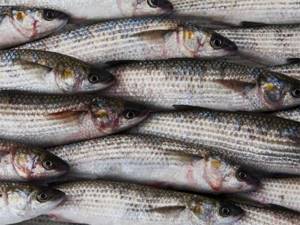
These areas are favorable for many species. Red mullet (ramada) and corsula are intensively caught here. India, Pakistan, and Burma massively breed corsula mullet in aquaculture.
Species are widely represented in the Black Sea and the Sea of Japan, but the Black Sea mullet, sharpnose, singil and Japanese pelengas are more common. Recently, the Black Sea mullet has been introduced into the Caspian Sea.
The nutritional value
Vitamins
Macronutrients
Microelements
- Due to the high level of vitamin A, fish is useful for improving the condition of the skin and mucous membranes. It is needed to maintain vision. It cannot be replaced by anything, only in animal origin.
- Vitamin B4 helps with liver function and reduces cholesterol levels in the blood. It also improves cardiovascular activity, normalizes the amount of insulin, and removes harmful substances from the body.
- Choline promotes weight loss.
- Of course, mullet also contains phosphorus. This vitamin affects the structure of the skeletal system. Daily norm: children – 1500-1800 mg, adults – 1600 mg. Phosphorus takes part in the body's metabolic processes, creates conditions for good kidney function and cell growth, and has a great influence on the functioning of the central nervous system, skeleton and heart muscles, and sweat glands.
- Thanks to the fatty acids contained in fish, brain function improves and the risk of heart problems is reduced. By regularly eating mullet, you can completely eliminate the risk of heart attack or stroke.
- The properties of this fish include the fact that it is a unique source of first-class protein, which contains amino acids that are essential for the human body.
- According to research, mullet helps restore nerve cells. Eating mullet 2-3 times a week has a chance to overcome problems with depression and bad mood.
- Due to its properties, mullet cannot be replaced with anything for intestinal diseases (both chronic and acute). Doctors recommend eating this fish regularly with green and red vegetables and cereals.
- The popularity of the benefits of mullet helped it get into the main dishes of chefs. Today, every restaurant has many recipes with the addition of fish. They prefer to bake it in foil with vegetables and fry it over an open fire. Cooking in this way reduces the risk of arrhythmia.
- It is recommended to consume mullet for people with atherosclerosis lesions. Better baked or boiled. It is often recommended that older people eat this fish.
Mullet is a small commercial fish that prefers to live in brackish or sea waters, mainly warm, tropical seas. This fish is found in large quantities in the Black and Azov Seas, where as many as 4 species of mullet are represented. Mullet is a fairly active fish and moves into the sea mainly in a school.
A feature of this fish is a rather interesting reaction to fright - they jump out of the water quite quickly and deftly, in some cases they even manage to bypass the fishing nets that are set out to catch them. Mullet reaches maturity by the 8th year of life, at this age their size is approximately 30-40 centimeters. All types of mullet are very similar in appearance, so inexperienced fishermen can confuse them.
Externally, the mullet is a very beautiful fish, its body is quite slender, its mouth is small, its scales are quite large, and the color is shiny with a shade of silver. The external distinctive feature of the mullet is that its upper part is dark blue, and the lower part is silver-white, as well as the fact that black stripes can be seen on its body.
The benefits of mullet have been known to everyone since ancient times, naturally, due to the fact that it is rich in useful minerals and trace elements, as well as substances that are of great value for the human body. Also, the beneficial properties of mullet are due to the presence of a large amount of fats and amino acids, which also exclusively benefits the consumer.
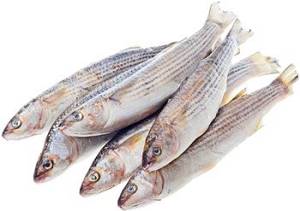
The benefits of mullet have contributed to its spread in cooking all over the world; today, in any large fish restaurant you can find many dishes made with the addition of mullet; this fish is preferably baked in foil along with vegetables or fried over an open fire, mullet prepared in this way helps reduce the risk of heart arrhythmia in humans.
The beneficial properties of mullet are due to the content of polyunsaturated fatty acids Omega-3, it is thanks to them that the appearance of various blood clots or clots in blood vessels is prevented in our body, in addition, these acids help maintain the condition of various small vessels and normalize the activity of arteries.
Mullet has a particularly beneficial effect on the body of those people who suffer from diseases associated with the gastrointestinal tract and atherosclerosis. The calorie content of mullet is very low, so many nutritionists advise their patients to eat this type of fish regularly, combine it with green and red vegetables and, occasionally, with cereals.
Harm from mullet can only occur if a person is allergic to fish, then it is advisable to limit the consumption of mullet.
Energy ratio (b|w|y): 80%|20%|0%
This fish has valuable, tender, tasty meat. Its benefit is the rich chemical composition of mullet.
Due to its richness in vitamin A and vitamin E content, fish has a beneficial effect on the condition of the skin. And the saturation of vitamin A allows you to maintain normal vision and its sharpness. B vitamins in fish reduce cholesterol levels, improve cardiovascular activity, and normalize insulin levels.
Choline in fish helps reduce weight. Phosphorus has a beneficial effect on the skeletal system and its development. This is especially useful for children, given that fish is non-bony. Phosphorus in mullet also promotes the functioning of the kidneys, central nervous system, and heart muscles. Fatty acids in fish improve brain function and support normal heart function.

Consuming the product three times a week helps combat depression. This fish is very good for intestinal diseases, because it is easily digested and absorbed. Nutritionists advise using it with vegetables and cereals. It is preferable to bake in foil with vegetables, grill, or stew. People with atherosclerosis are recommended to consume it in baked or boiled form. Based on the above, mullet is very useful for older people.
Delicious dried and smoked products are prepared from mullet, but its consumption is only possible if you have complete order with the gastrointestinal tract. Canned food from this sea fish also turns out to be appetizing.
- Due to the high level of vitamin A, fish is useful for improving the condition of the skin and mucous membranes. It is needed to maintain vision. It cannot be replaced by anything, only in animal origin.
- Vitamin B4 helps with liver function and reduces cholesterol levels in the blood. It also improves cardiovascular activity, normalizes the amount of insulin, and removes harmful substances from the body.
- Choline promotes weight loss.
- Of course, mullet also contains phosphorus. This vitamin affects the structure of the skeletal system. Daily norm: children – 1500-1800 mg, adults – 1600 mg. Phosphorus takes part in the body's metabolic processes, creates conditions for good kidney function and cell growth, and has a great influence on the functioning of the central nervous system, skeleton and heart muscles, and sweat glands.
- This type contains a lot of vitamin A. As is known, this vitamin is useful for improving the condition of human mucous membranes and skin. At the same time, vitamin A is essential for maintaining vision and eye health. Vitamin A obtained from animal sources cannot be replaced by plant foods.
- Contains a lot of vitamin B4. This vitamin helps reduce cholesterol levels in the blood, also helps the liver, and is involved in the functioning of the cardiovascular system. Helps remove harmful substances from the body, thereby purifying the blood, regulates the amount of insulin contained in the blood.
- Vitamin Choline, which is quite rare in food products, is recommended to be consumed in large doses if you are overweight or obese; it promotes weight loss. It is also present in some quantities in mullet.
- Like many other species, mullet contains some amount of phosphorus. This substance has a beneficial effect on the human musculoskeletal system, in particular on the condition of the bones. Phosphorus is also an indispensable participant in metabolic processes, has a beneficial effect on kidney function, and stimulates cell growth. In addition, the microelement affects the central nervous system, heart muscle, as well as the sweat glands, which regulate sweating.
- This fish contains a considerable amount of fatty acids. Thanks to them, it is possible to improve brain function. Regular consumption of sufficient amounts of these substances reduces the risk of vascular and heart diseases. Thus, regularly eating mullet helps reduce the risk of diseases such as stroke or heart attack.
- Protein, which makes up about 20% of the weight of fish, contains essential amino acids.
- According to studies, regular consumption of this fish helps restore nerve cells. The substances it contains help fight certain mental disorders, such as depression, and they also help overcome bad mood. It should be noted that this property of mullet appears only when taken regularly, for example, two to three times a week.
- This type is allowed and recommended for use for intestinal diseases, including chronic ones, and is also recommended in the diet menu. It is advisable to eat it for medicinal purposes with vegetables or side dishes of cereals. And it is also advised to include mullet in the diet of older people, since regular consumption prevents atherosclerosis.
- Fortunately, there are no special contraindications for use. Basically, those who have acute food intolerance to it or an allergic reaction should avoid eating such fish. Harm from mullet can occur if the product was chosen to be of poor quality or poorly prepared.
- To avoid this, you should pay special attention to choosing a fresh carcass, and, if you have a choice, buy only freshly caught ones. Unfortunately, this opportunity is available only to residents of coastal areas. Otherwise, you should choose fresh frozen. Frozen fish should be labeled with the date it was caught and when it was frozen.
- The greatest number of beneficial properties is in fish that was caught no later than 48 hours ago. This means that in order to benefit from frozen mullet, it must be frozen immediately after being caught.
- When preparing such a product at home, you can defrost it only in air, but not in water. After defrosting, the fish must be cooked immediately.
- Description and photo
- Where is it found?
- How to cook
- Price
- Interesting Facts
- Reviews
- Video
Mullet in cooking
In stores, this type of marine representative is found in all gastronomic states: smoked, dried, frozen. Canned food is made from miguli; they are presented on the shelves in a wide range.
Modern housewives manage to prepare all types of dishes from mullet, with the exception, perhaps, of dessert. From the representative of the seabed they make fish “fingers” - small breaded cutlets, chips, snacks, first and second courses. Miguli is used to make fish soup and fish soup, and stew mullet with vegetables. Men who love a foamy drink prefer dried and smoked mullet as a snack for beer.
Mullet goes perfectly with almost all vegetables; rice is usually served as a side dish.
Before cleaning, it is recommended to briefly immerse the miguli carcass in boiling water . 30 seconds will be enough.
It is recommended to prepare fish sauce from sour cream or tomato juice.
You should know that migulya stewed with vegetables loses its calorie content. For example, the calorie content of mullet stewed with potatoes is 79 Kcal.
Contraindications
This fish has no special contraindications for consumption. However, we should not forget that excessive consumption can lead to an allergic reaction. Fish is contraindicated for people with individual intolerance to some of the components included in the fish.
The benefits of mullet
Nutritional information |
Vitamins | Minerals How much does Mullet cost (average price per 1 kg)?
Moscow and Moscow region.
250 rub.
Mullet is a small commercial fish that prefers to live in brackish or sea waters, mainly warm, tropical seas. This fish is found in large quantities in the Black and Azov Seas, where as many as 4 species of mullet are represented. Mullet is a fairly active fish and moves to the sea mainly in a school.
A feature of this fish is a rather interesting reaction to fright - they jump out of the water quite quickly and deftly, in some cases they even manage to bypass the fishing nets that are set out to catch them. Mullet reaches maturity by the 8th year of life, at this age their size is approximately 30-40 centimeters. All types of mullet are very similar in appearance, so inexperienced fishermen can confuse them.
Externally, the mullet is a very beautiful fish, its body is quite slender, its mouth is small, its scales are quite large, and the color is shiny with a shade of silver. The external distinctive feature of the mullet is that its upper part is dark blue, and the lower part is silver-white, as well as the fact that black stripes can be seen on its body.
The benefits of mullet have been known to everyone since ancient times, naturally, due to the fact that it is rich in useful minerals and trace elements, as well as substances that are of great value for the human body. Also, the beneficial properties of mullet are due to the presence of a large amount of fats and amino acids, which also exclusively benefits the consumer.
The benefits of mullet have contributed to its spread in cooking all over the world; today, in any large fish restaurant you can find many dishes made with the addition of mullet; this fish is preferably baked in foil along with vegetables or fried over an open fire, mullet prepared in this way helps reduce the risk of heart arrhythmia in humans.
The beneficial properties of mullet are due to the content of polyunsaturated fatty acids Omega-3, it is thanks to them that the appearance of various blood clots or clots in blood vessels is prevented in our body, in addition, these acids help maintain the condition of various small vessels and normalize the activity of arteries.

Mullet has a particularly beneficial effect on the body of those people who suffer from diseases associated with the gastrointestinal tract and atherosclerosis. The calorie content of mullet is very low, so many nutritionists advise their patients to eat this type of fish regularly, combine it with green and red vegetables and, occasionally, with cereals.
Harm from mullet can only occur if a person is allergic to fish, then it is advisable to limit the consumption of mullet.
Intraspecific differences
The mullet family contains almost 80 species in 17 genera, with half of the species represented by two main genera. They are distinguished by their appearance, which determines the name: smooth-lipped, sharp-snouted, bearded, big-headed, big-nosed, yellow-eyed mullet.
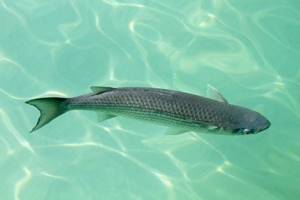
Two types are more common: silver and red mullet. Moreover, almost 40 species of red mullet alone are known. The color of the silver mullet can vary from blue-gray to olive green. Among freshwater mullets, the striped or black mullet predominates.
The most famous types can be characterized as follows:
- Loban. The length of individuals is up to 80 cm, maximum weight is about 3.0 kg. The side of the body is covered with dark stripes.
- Sharp Nose. The species is not large, up to 25 cm long, with an average weight of no more than 500 g.
- Singil is more common in the Black Sea. The average length of the body is about 35 cm. It is distinguished by a bright orange-yellow spot on the head.
- Hoturo is a rare freshwater species.
- Pelengas is from. The most unpretentious type. It has a narrower, lower dorsal fin, orange eyes, and large yellowish scales that even cover the head. Not afraid of shallow water.
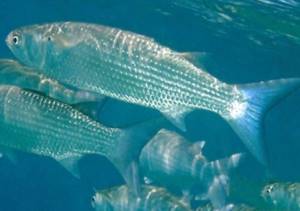
According to the names of the seas, the fish that live in them are distinguished:
- Black Sea mullet (chularka) with large eyes and small mouth. The average size of individuals is within 40 cm.
- The Caspian mullet is larger than the Black Sea mullet.
- Azov mullet is smaller, but fattier.
Mullet fishing
In Russia, they have been successfully fishing for centuries using various gear on the coasts of the Black, Caspian and Azov Seas. Every year, recreational fishing turns into a kind of “pilgrimage.”
The value of mullet in Crimea cannot be compared with fishing for even rare and large trophies on the rivers. It occupies a leading place in terms of the severity of impressions. There are a thousand and one fishing tackles. Each fisherman has his own. They catch it with a spinning rod, a float, a donka, and some “craftsmen” even use a feeder. Locals develop their own ingenious gear, where, for example, a French loaf can serve as a feeder, sinker or float. Fish is a gourmet, it will not eat everything. Many fishermen who come here on vacation often complain that you can’t try out all the gear in such a short time. But first things first.
Fishing from the shore
In the Black Sea, fishing is successful all year round. In spring, summer and fall, it is effective to place your gear on the shore. In summer, when fishing is especially popular, fish are looked for in feeding areas. These are ports, river mouths, estuaries. They are caught from the shore, various hydraulic structures, piers, rocks and piers. A boat is not needed in the warm season, and sometimes it is ineffective. Mullet, as you know, sees well and when a watercraft approaches, the school, if it feeds near the surface, will simply go to another place.
Visitors often get their bearings by looking at the locals, where there are a lot of people with fishing rods and donks, and there is fish there. Fortunately, unlike the river bank, there is enough space for everyone on the coast. If a school is discovered, then you can stay there for a long time, it won’t go anywhere. In the Caspian and Black Seas it is active all day long and does not take breaks for “lunch naps”. It is also interesting that it is not difficult for experienced fishermen to find mullet. On warm days, the flock stays above the sandy bottom near the shore, where the dark backs are clearly visible.
At the end of July and beginning of August it goes to spawn. Moves to saltier water. During this period, they search for it in bays, estuaries and bays. The flocks extend approximately two kilometers from the coastline. The fish is looking for deeper places. Therefore, fishing from the shore becomes ineffective during this period. It is worth distinguishing between migrating schools and flocks that feed. This is important especially in spring. Migrating - it does not stay in one place for a long time, so you often have to follow it along the shoreline.
Weather conditions and fishing time
Like many marine species, it feeds in the morning. At this time, it is possible to catch large individuals before they have moved further from the shore. During the day, the bite is observed consistently, but the fish on the hook are medium and small. At night they fish further from the coastal zone on boats.
The effectiveness of fishing is also determined by weather conditions. On a cloudy day, contrary to accepted logic, there are more fishermen along the shore than when the sun is shining brightly. In this weather you can catch big fish all day long. When a slight wind blows and it drizzles, flocks enter lagoons and small bays. This is due to the fact that in such conditions shrimp, small fish and crustaceans become active and serve as food. In such weather, fishing becomes especially successful.
Fishing gear
Fishing methods are very diverse. This could be a spinning rod or a float rod. Many people cannot understand how they can successfully fish with everything at once. But in reality, there are some nuances in the equipment that a fisherman who fishes on rivers will not even guess about.
The most popular tackle is a float rod. If there is a feeding spot, this is an almost guaranteed successful fishing. The thinnest fishing lines are used, no more than 0.20 mm. Hooks should have a short shank, No. 4-5. The float is installed sensitive in the shape of a pear. It must be stable, it is also important that the color be camouflage, most often it is green. When fishing, do not make sudden movements. The mullet has excellent vision and, when frightened, the flock can leave.
Bottom tackle is no less popular. It is also made from thin fishing line, the hooks are the same as for the float. But there is a peculiarity - small green floats are attached to the hooks on monofilament leashes, which lift them 5-10 cm from the bottom (they are also placed on the float). This is necessary because the fish feed in the thicker areas, therefore. In the Black and Caspian Seas they also fish with spinning rods. Large fish willingly go for small spinners, the so-called “fly spinners”. Light color is preferable, the depth of the spinner is no more than 1 meter. The bite of large mullet is always unexpectedly brisk for beginners. When the fish bites, it hooks itself.
Bait
Nereis estuary worms are used as the most effective bait for fishing in the coastal zone. You can attach sandworms to the hook. Less effective is mussel meat. Many people use French brioche crumbs drizzled with anise oil. It is important that in river mouths the best bait is dung and earthworms.
Lure
In the Black Sea they feed on certain sections of the beach. This bait is very effective. The locals have developed a rather interesting bait mixture. It consists of bread (often “Turkish” loaves), wheat flour, minced anchovy and processed cheeses (“Viola” or “Yantar”). This mixture is certainly recognized as universal and brings high catches.
Fishing in winter
Every winter, hundreds of fishermen come to Crimea. They look forward to this time. At the beginning of January, in especially warm years a little later, schools of mullet escaping storms enter the bays of Sevastopol. Numerous schools accumulate here, marking the beginning of the season with their appearance. From now on, every early morning numerous boats and boats with fishermen on board will depart from the shore. This is the beginning of the famous winter Crimean mullet fishing!
If we approach it from a practical point of view, there are no big differences in summer and winter gear. Unless, when fishing from a boat, you can do without a float on a float rod. It is also not necessary to equip the hooks with small green floats, which are indispensable in the summer. Prey in winter reacts well to bait anyway.
As for the bait, in the cold season it is mandatory to have Nereis sea worms strung on the hooks. Without them there is nothing to catch. At this time, this bait is sold in any local fishing store. As mentioned above, in winter they catch more often from a boat. Any watercraft will do: from a boat to an inflatable boat. But locals also fish from the shore. The preferred gear in winter is not a donka or a spinning rod, but a float rod.
